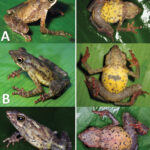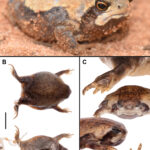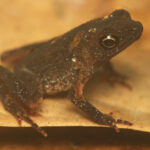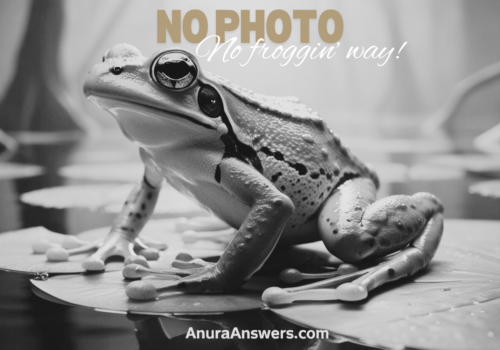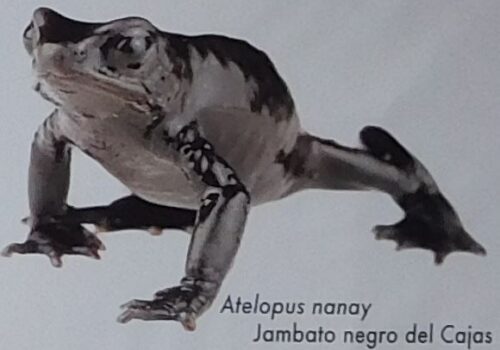- Introduction: A Precious Jewel Amidst Colombia’s Cloud Forests
- Taxonomy and Classification: Understanding the Lineage
- Natural Habitat: Life Among the Clouds
- Physical Characteristics: A Radiant Amphibian Treasure
- Behavior and Life Cycle: Hidden Lives in a Fragile World
- Ecological Role: A Key Species Within a Complex Web
- Threats and Conservation Status: Standing on the Brink
- Cultural and Scientific Significance: A Symbol and Sentinel
- Conclusion: Safeguarding an Amphibian Jewel for Future Generations
Introduction: A Precious Jewel Amidst Colombia’s Cloud Forests#
Deep within the mist-laden cloud forests of Colombia, nestled among lush mosses and verdant foliage, resides the Atelopus nicefori—a small, brilliantly colored amphibian whose existence whispers secrets of an ecosystem in delicate balance. Commonly known as Niceforo’s Harlequin Frog, this remarkable species belongs to the diverse and enchanting Atelopus genus, characterized by vibrant patterns of yellows, reds, and deep blacks. While small in size, Atelopus nicefori carries profound ecological significance, acting as an indicator of environmental well-being. Yet, despite its striking beauty and the critical role it plays, this enigmatic amphibian teeters precariously close to extinction.
Atelopus nicefori, like a shimmering gemstone hidden in nature’s extensive catalogue, confronts intense pressures from habitat destruction, climate changes, and relentless disease. A vital part of Colombia’s biodiversity narrative, its struggle is a gentle yet urgent reminder of our interconnectedness with nature’s intricate web. Journey with us as we delve into the remarkable story of Atelopus nicefori—a creature as captivating as it is vulnerable—and explore why protecting this charismatic amphibian is essential for our shared future.
Taxonomy and Classification: Understanding the Lineage#
Atelopus nicefori belongs to the Bufonidae family, commonly known as “true toads,” despite the brightly-hued appearance that distinguishes them sharply from typical toad stereotypes. Within the genus Atelopus, this species stands alongside approximately 96 closely related species, many of which share similar ecological dynamics and evolutionary histories.
This species was first scientifically described by Cochran and Goin in 1970. Named in honor of renowned Colombian naturalist Hermano Nicéforo María, Atelopus nicefori symbolizes the rich biodiversity and dedicated scientific inquiry that Colombia fosters.
Natural Habitat: Life Among the Clouds#
The elusive Atelopus nicefori exclusively inhabits the montane cloud forests and sub-páramo habitats of Colombia’s lush Andean region, particularly in the northern Cordillera Oriental. These high-altitude ecosystems, draped in perpetual mist and rich with biodiversity, offer a damp and cool climate perfect for survival—a haven for moisture-loving amphibians.
The Mystique of Cloud-Forest Ecology#
Picture an almost ethereal forest, enveloped by gentle mists that eternally swirl among towering trees and dense, emerald canopy. Beneath sturdy branches laden with lichens and mosses, delicate orchids and bromeliads thrive, providing hidden sanctuaries and hunting grounds for tiny inhabitants. It is here, along clear mountain streams or sheltered beneath damp leaves, that Atelopus nicefori finds its perfect refuge.
This specialized habitat, characterized by dense vegetation and consistently humid air, supports the frog’s porous skin and unique biology. Clear, unpolluted streams offer ideal breeding grounds, where eggs and tadpoles develop in relative safety, shielded from predators and harsh environmental influences.
Physical Characteristics: A Radiant Amphibian Treasure#
Atelopus nicefori captures attention immediately with its vivid and contrasting body markings. Adult individuals typically measure just 20 to 40 millimeters in length, their compact bodies a canvas for intricate patterns colored in striking shades of yellow, deep black, brownish-red hues, and vivid greens. Such striking coloration functions as a warning (aposematism) to potential predators, signifying potent chemical defenses concealed within their delicate skin.
The brilliance of such colors not only provides a defense mechanism but offers a perfect camouflage within the bright lichens and colorful leaves that define their cloud-forest environment. Their robust yet streamlined bodies boast longer hind limbs and delicate fingers with small digital pads that aid elegant maneuvers among mossy branches and slippery stones.
Behavior and Life Cycle: Hidden Lives in a Fragile World#
Life for Atelopus nicefori unfolds quietly across Colombia’s mist-shrouded terrain, marked by fascinating behaviors integral to its survival in these demanding habitats. Primarily diurnal, the frogs actively forage during daylight hours, preying upon an assortment of small insects, such as ants, beetles, and tiny arthropods inhabiting leaf litter and vegetation.
Mating Calls Amidst Misty Streams#
Within the cool tranquility of the Andean forests, breeding rituals unfold with remarkably subtle yet beautiful complexity. Male Atelopus nicefori positions themselves strategically along crystal-clear streams and gently flowing waterways, emitting quiet yet distinct calls to attract female counterparts. The soft murmurs, barely audible amidst murmuring brooks, create a gentle symphony that echoes through their mist-strewn habitat.
Females typically attach clusters of eggs underneath river stones or vegetation submerged in shallow clear streams. Tadpoles emerging from these protective clusters embark on aquatic lives within safe watery alcoves, grazing algae and developing in comparatively calm conditions, before metamorphosing into vibrantly colored froglets and joining their adult counterparts.
Ecological Role: A Key Species Within a Complex Web#
While humble in stature, Atelopus nicefori plays an outsized ecological role within the biodiversity-rich environments it inhabits. As both predator and prey, these harlequin frogs regulate insect populations, maintain ecological balance, and sustain a biodiversity equilibrium critical to overall environmental health. Beyond prey management, they fulfill trophic interactions, acting as essential food sources for various predators, including snakes, birds, and larger amphibians.
Perhaps most importantly, Atelopus nicefori serves as an indicator species, providing invaluable biological insights into the environmental state and stability of their delicate ecosystems. Scientists rely on amphibians like these as early-warning signals capable of highlighting subtle ecological disruptions—a critical tool for conservationists and environmental stewards.
Threats and Conservation Status: Standing on the Brink#
Alarmingly, Atelopus nicefori is currently classified as Critically Endangered according to the International Union for Conservation of Nature (IUCN). Population numbers have dramatically declined over recent decades, driven primarily by habitat loss, water pollution, climate change, and especially the devastating effects of chytrid fungus (Batrachochytrium dendrobatidis).
Chytridiomycosis: The Hidden Amphibian Plague#
Chytrid fungus has emerged as a global threat, driving many amphibians toward extinction with chilling efficiency—Atelopus nicefori among them. This pathogen infects amphibian skin, disrupting critical respiratory and hydration functions. Compounded by changing climates and habitat fragmentation, impacted populations struggle greatly to rebound.
Conservationists nationwide have mobilized to implement protective measures, habitat restoration initiatives, disease management protocols, and breeding programs in captivity—including targeted awareness campaigns aimed at community engagement promoting environmental stewardship.
Cultural and Scientific Significance: A Symbol and Sentinel#
Within Colombian folklore and cultural narratives, frogs symbolize fertility, rain, and balance between humanity and nature. The vibrant Atelopus nicefori, with its stunning appearance and fragile beauty, encapsulates these evocative connections profoundly, capturing imagination while promoting biodiversity conservation awareness at a broader public scale.
Furthermore, this unique amphibian has contributed significantly to scientific research, shedding light on important ecological concepts involving amphibian declines, species resilience, disease dynamics, and climate adaptation. Indeed, the study of Atelopus nicefori emphasizes crucial understanding necessary to environmental conservation and sustainability efforts globally.
Conclusion: Safeguarding an Amphibian Jewel for Future Generations#
Ultimately, Atelopus nicefori embodies nature’s wonder and vulnerability intertwined—the fragility of our ecosystems laid bare in its existence. Its survival rests upon proactive intervention, dedicated research, and public awareness highlighting its significance beyond mere aesthetics. In understanding and safeguarding this charismatic frog, we acknowledge and protect the integrity of an ecosystem upon which countless organisms—and ultimately ourselves—depend.
As stewards of Earth’s precious life forms, each individual holds power to foster change through education, advocacy, and mindful environmental actions. Together, we can ensure this treasured Colombian amphibian continues to enchant, inspire, and teach future generations, safeguarding the magical balance woven throughout our planet’s intricate tapestry of life.
Your next step? Get involved or learn more about conservation programs protecting Colombia’s unique amphibians, such as Atelopus nicefori, and become part of the global effort towards biodiversity preservation and sustainable future stewardship.


